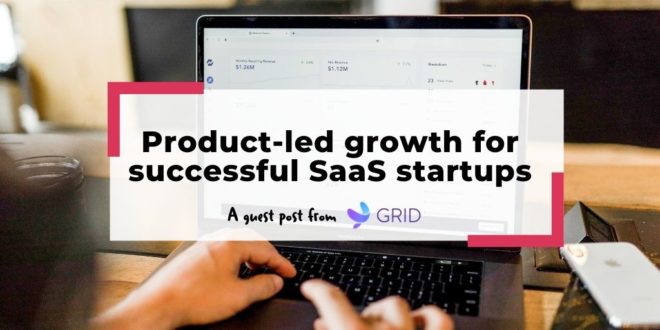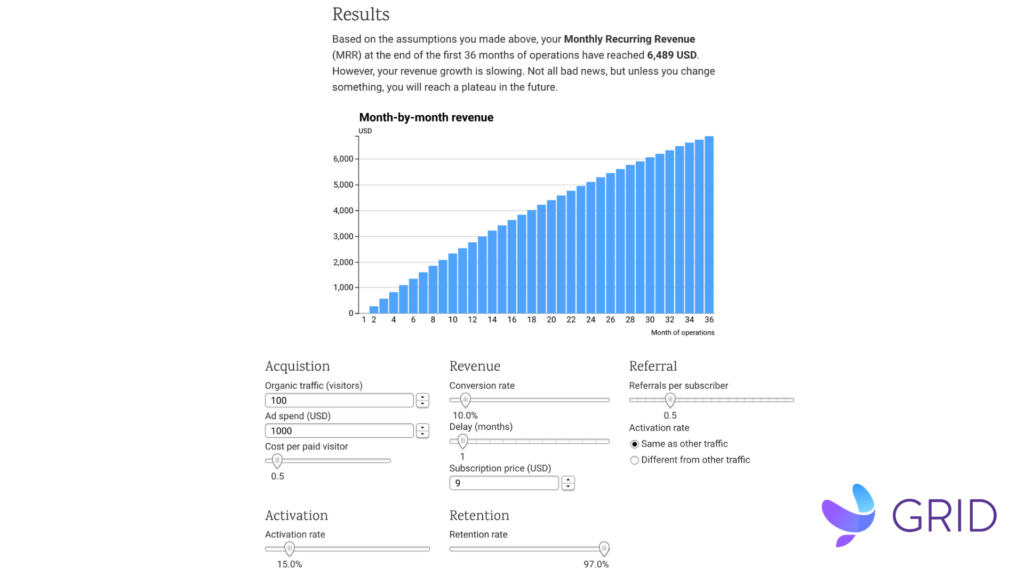This is a guest post by Hjalmar Gislason, founder and CEO of GRID, a SaaS startup based in Reykjavik Iceland. GRID is a productivity tool that transforms your spreadsheets into shareable, interactive web documents.
What is product-led growth and why does it work?
If you’ve ever taken a car for a test drive, you understand the fundamentals of product-led growth. Product-led growth (or PLG for short) isn’t a new concept – it’s been an extremely effective method of acquiring and upselling customers for a long time.
Consider how you prefer to approach new products or services. For most of us, the opportunity to test a product out – whether it’s a vehicle, a free sample at the grocery store, or an app – is empowering. Consumers appreciate having space free from a sales agent to see how a particular solution or product fits into their lives and established ways of working.
Modern day SaaS companies are building on this concept by leveraging the product to do even more. PLG is a growth model that uses the product to simultaneously acquire, convert, retain and expand the customer base.
Successful SaaS businesses also aim to create feedback loops within their product. These loops are built into the natural usage of the product and become key engines for growth as their effects compound over time. For example, the output of a product could be exposure to new leads, which become users who in turn generate exposure, and consequently their own leads. Combined with word of mouth, both of these mechanisms provide the basis of your organic distribution channel (more on this later).
The key to achieving such outcomes with your product comes down to the core principle of PLG – obsessive focus on your end-users and the quality of their experience across the whole of their lifecycle. Providing an exceptional user experience will acquire and retain users, and then grow that user base. We’ve seen this in instances of successful SaaS products where users begin to feel as if the software is indispensable. Zoom and Dropbox are great examples of product-led solutions that have reached near-ubiquity in global workflows.
Ubiquity and product-loyalty doesn’t happen overnight, however. The SaaS landscape is evolving at the speed of light and it’s never been more essential to meet and exceed user expectations. This is in large part due to both the quality and quantity of competition – users no longer put up with subpar UI/UX or tedious onboarding. They have the power, so our aim is to show them maximum value.
How do you help customers discover your product’s value?
Evaluate product-market fit regularly
To paraphrase Sean Ellis, getting the right people to have the right experience will naturally generate word of mouth. Evaluating your product-market fit is crucial to understanding what a particular group of users need at any given point in time. Doing so on a regular basis ensures that you are targeting the optimal audience for your product in an ever-changing environment, and might even reveal surprising new opportunities.
Sustainable product-led growth relies on correct product-market fit to acquire and retain a healthy percentage of target users.
Identify and eliminate value gaps
In all honesty, if there’s a big difference between the customer’s perception of a product’s value and what they actually experience, conversions and referrals will grind to a halt pretty quickly. The value customers experience in order to be delighted needs to be exceptional within the current highly competitive SaaS landscape.
Enable quick adoption
What’s your product’s time to value (TTV)? That is, how long does it take for people to really experience the value of your product? Introduce your full product to users right away, so they can see what value it may have for them. Placing emphasis on responsive customer success management is another essential factor for improving adoption rates – if users know that they can access support at any time, they’ll feel more comfortable committing to your product. Make early product engagement effortless – it will gradually convert into customer retention. Consider also:
- Offering a freemium subscription model
- Creating a show-stopping product tour
- Experimenting with iterations of your signup and onboarding flows to find what’s most effective
Straightforward onboarding
A simple and inviting onboarding journey provides the straightest path to value. A product sells itself the moment a customer experiences and understands its value.
- Does your product tour outline user benefits in as few steps as possible?
- Are you providing clear, contextual guidance to facilitate flow and ‘guide to value’?
- Have you ensured that tooltips are informative and judicious? Do you avoid overwhelming users?
- Are you aware of steps like email activation that often deter customers? How is your business addressing this?
Leverage both quantitative and qualitative data
Performing analytics and gathering qualitative data through surveys and webinars, one-on-ones, and excellent customer success management will help you answer crucial questions:
- How many of the customers who signed up actually saw value in the product?
- What specific features does a user need to discover to drastically increase their likelihood of adoption?
- Where are customers hesitating?
Find out if users aren’t becoming active in the product after signup, aren’t sharing assets, or are simply losing interest due to friction during the onboarding process. Your user analytics will spotlight the right time to reach out to customers during their journey so you can keep them engaged and prompt the action you want to encourage.
PLG in practice: An interactive product-led growth calculator
Let’s look at an example that puts PLG in context. This interactive Product-Led Growth Calculator is a model that assumes a simple business with a single subscription product, at a single pricing tier. However, it can be easily adapted to include a different set of assumptions representing a more complex business.
Built on a single spreadsheet, this model visualizes key data in a clear, accessible way, with an accompanying narrative to guide viewers through the analysis. Interacting with the model and changing assumptions facilitates a better understanding of the growth levers in the framework and how they may apply to your PLG business.
Unlocking referrals and organic user acquisition channels
In the world of PLG, word of mouth is gold. And I would argue that it’s always been that way in the eyes of consumers. Growth can’t be supported exclusively by paid campaigns – a successful SaaS will need to find a healthy balance between paid and organic acquisition. As mentioned above, an ideal scenario introduces new users to a product as a side-effect of natural usage. The effects of built-in distribution are significant with communication tools like Slack (it has no value without your friends and colleagues), and are also quite strong in creative tools where the main purpose of using the product is to share with someone else. So how can you unlock this potential?
- Target a massive audience. Successful PLG relies on a high density of potential customers to build organic momentum and wide-spread distribution.
- Invest effort in boosting organic user acquisition. This can include rigorous SEO and increasing discoverability in marketplaces.
- Eliminate as much friction as possible in the user flow in order to generate referrals, which can include everything from sharing content to inviting friends and colleagues. Incentivizing the process can further boost referrals by making sharing a rewarding experience.
Key takeaways:
Fundamentally, successful SaaS startups are motivated by a desire to make their customer’s lives easier.
- Approach your end-users with respect and take time to understand their needs – product-market fit is the key, and product-led growth is fuelled by customer satisfaction.
- Meet expectations – or better yet, exceed them. Your target customers are faced with many viable options competing to meet their needs.
- Facilitate a streamlined onboarding journey so that even non-tech users can learn how to use your product and effortlessly experience its value.
- It takes time to build an organic network, so you need to start as early as possible. Believe in word of mouth referrals and harness the power of delighted customers.
- Work to achieve sustainable growth within economic parameters that make sense for your company. Continuously monitoring analytics and gathering qualitative data points to steer decision-making will help you understand what is working and identify friction points to eliminate. This allows you to focus on the customers who need your product the most.
Building a committed user base for your product begins by ensuring an exceptional user experience – one that will unlock your long-term primary distribution channels (referrals and organic traffic) to drive sustainable growth and fully enable your product to sell itself.
About the author
Hjalmar Gislason is the founder and CEO of GRID. Founded in 2018, Icelandic SaaS startup GRID is on a mission to revolutionize the way people communicate with data. GRID is a productivity tool that empowers professionals to transform spreadsheets into interactive, visually dynamic web documents, making sharing and presenting spreadsheet data smart, quick, and exceptionally valuable.






